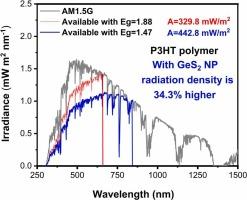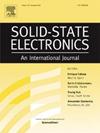用循环伏安法估计有机太阳能电池供体-受体聚合物的能级
IF 1.4
4区 物理与天体物理
Q3 ENGINEERING, ELECTRICAL & ELECTRONIC
引用次数: 0
摘要
循环伏安法是一种强大的电化学工具,用于获得聚合物的电学性质,如能级。本文通过改变GeS2纳米粒子来估计供体聚合物P3HT和受体聚合物PC61BM的HOMO和LUMO能级,以及估计其他参数,如Eg, ΔLUMO和理论Voc。将所得数据与P3HT:PC61BM:GeS2倒置有机太阳能电池的实验进行对比,以确定GeS2对能量水平和太阳能效率的影响。在不添加纳米粒子的情况下,P3HT和PC61BM的Eg分别为1.88 eV和2.25 eV。此外,还发现Voc为1.13 V, Edis为0.76 V。然而,GeS2纳米颗粒的加入改变了这些值,发现0.75 wt%的GeS2将P3HT和PC61BM的Eg分别修饰为1.47 eV和2.52 eV, Voc为1.31 V, Edis为0.15 V。理论Voc与实验Voc和PCE之间存在一定的相关性,实验结果表明,0.75 wt%的纳米颗粒的最大效率为2.18%,平均器件效率为1.99%。本文章由计算机程序翻译,如有差异,请以英文原文为准。

Estimation of the energy levels of the donor–acceptor polymers of organic solar cells using cyclic voltammetry
Cyclic voltammetry is a powerful electrochemical tool for obtaining electrical properties as energy levels in polymers. Herein, it has been used to estimate the HOMO and LUMO energy levels of the donor and acceptor polymers, P3HT and PC61BM, by varying of GeS2 nanoparticles, in addition to estimating other parameters such as the Eg, ΔLUMO, and the theoretical Voc. The data obtained were contrasted with an experiment of P3HT:PC61BM:GeS2 inverted organic solar cells to determine the influence of GeS2 on the energy levels and the reported solar efficiency. Without the addition of nanoparticles to the polymer samples, an Eg of 1.88 eV and 2.25 eV was obtained for P3HT and PC61BM, respectively. In addition, a Voc of 1.13 V and an Edis of 0.76 V were found. However, the addition of GeS2 nanoparticles modified these values, finding a substantial improvement with 0.75 wt% of GeS2 modifying the Eg to 1.47 eV and 2.52 eV for the P3HT and the PC61BM, respectively, with a Voc of 1.31 V and an Edis of 0.15 V. A correlation was found between the estimated theoretical Voc with the experimental Voc and the PCE. Precisely, the best experimental result was with 0.75 wt% of nanoparticles, obtaining a maximum efficiency of 2.18 % and an average device efficiency of 1.99 %.
求助全文
通过发布文献求助,成功后即可免费获取论文全文。
去求助
来源期刊

Solid-state Electronics
物理-工程:电子与电气
CiteScore
3.00
自引率
5.90%
发文量
212
审稿时长
3 months
期刊介绍:
It is the aim of this journal to bring together in one publication outstanding papers reporting new and original work in the following areas: (1) applications of solid-state physics and technology to electronics and optoelectronics, including theory and device design; (2) optical, electrical, morphological characterization techniques and parameter extraction of devices; (3) fabrication of semiconductor devices, and also device-related materials growth, measurement and evaluation; (4) the physics and modeling of submicron and nanoscale microelectronic and optoelectronic devices, including processing, measurement, and performance evaluation; (5) applications of numerical methods to the modeling and simulation of solid-state devices and processes; and (6) nanoscale electronic and optoelectronic devices, photovoltaics, sensors, and MEMS based on semiconductor and alternative electronic materials; (7) synthesis and electrooptical properties of materials for novel devices.
 求助内容:
求助内容: 应助结果提醒方式:
应助结果提醒方式:


